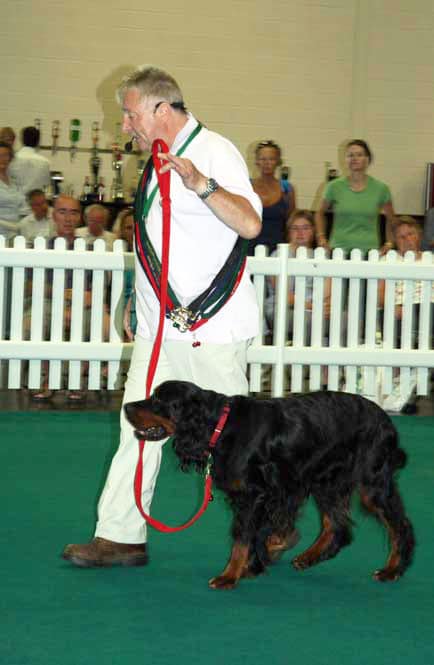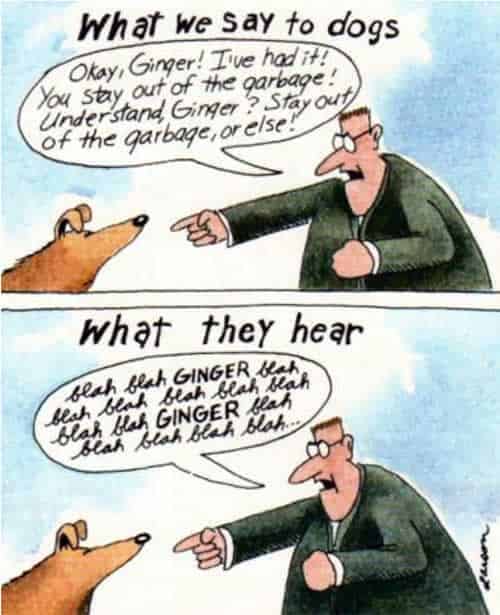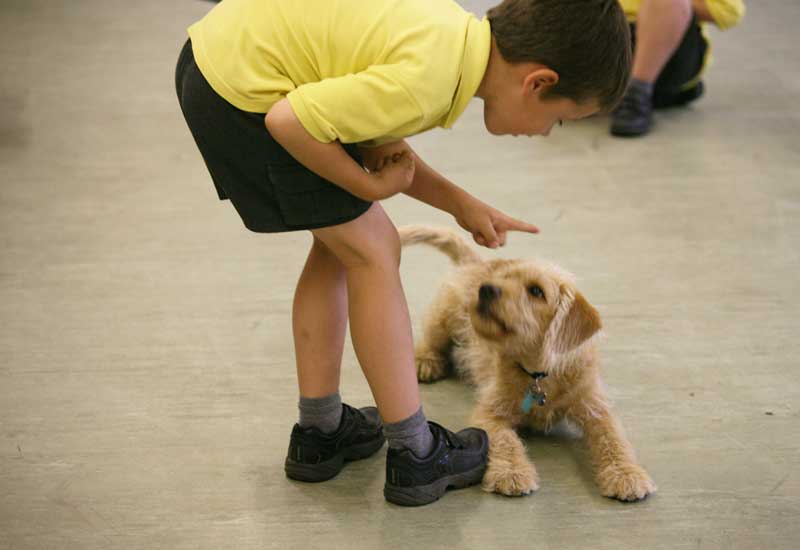Dog Communication and Commands
Understanding How Dogs Communicate

Why do we always expect our dogs to comprehend the nature and significance of our intricate language?
I cannot tell you how many times people have said to me that their dog thinks it’s human.
I always give the same answer “No it doesn’t it thinks you’re something other than a dog, but it never thinks it is human”
When we talk to our dog’s do we know how much they actually understand? Even their own name must be taught to them.
It does serve to emphasise that dogs are not humans in little furry coats.
Their method of communication is primarily body language, olfactory, and some verbal communication.
I have devised a training method that allows you to tell your dogs very quickly and easily what is acceptable behaviour and what is not.
The tool I use to stop lots of unwanted behaviours is called a Jingler.
I have appeared in shows all around the UK and Europe, taking dogs out of the audience and changing their behaviour in minutes with the use of the Jingler
The Jingler technique starts with the “OFF” command. And is brilliant at stopping a number of common unwanted behaviours.
The Jingler also stops jumping up, lunging and pulling on the lead as well as some types of aggression.
How you set this is by the use of a (1) Jingler. It will change the way you train your dog.
It is important to understand the triggers that allow dogs to understand what we are saying. It is also vital to know what commands to give in what circumstances. We often reward bad behaviour in our dogs because we do not understand when and when not to praise.
This article will help you understand how to communicate successfully with your dog. I conducted a survey over the last few years on what commands my clients used with their dogs.
97% used the word “NO” for almost every situation. 62% prefaced most of their commands with the dog’s name ie “Rover NO” “Rover Come” “Rover Sit”.

Gary Larsen a brilliant cartoonist who produces The Far Side; has an amazing insight and humour into human and animal behaviour;
He is very aware that words are not enough when communicating with a dog.
The owner scolding his dog shows what he is saying and what the dog actually hears.
“Oh Ginger, that was a bad thing. You’re a bad, bad dog, Ginger.”
What the dog hears is: “Blah Ginger, blah blah blah. Blah blah blah blah, Ginger.”
Since dogs must learn what each individual word means, all the other extra words are just a bunch of “Blah, Blah”
The problem with constantly using the dog’s name before a request or command is that it actually diffuses the command.
Watering it down to such an extent that it becomes the primary word that the dog picks out, often missing the command itself.
We also have a habit of barking commands at our dogs like a parade-ground sergeant major. Sometimes I have to tell my clients not to bellow at the dog.
For a sensitive and timid pet, this can be terrifying, and for a bold dog an excuse to bark back.
Sometimes I have to tell my clients not to bellow at the dog. For a sensitive and timid pet, this can be terrifying, and for a bold dog an excuse to bark back.
The other common error is using gender after saying “good” ie “good girl “or “good boy”
If we are going to use the word “GOOD” as a target word like a clicker, then we must keep it short and sweet.
Talk in soft conversational tones rather than barking commands, when requesting a dog to do something, like sit, stay, or down.
If you have made it clear what you want and the dog totally ignores you, then your voice can become more commanding. We don’t constantly bellow at people, therefore, why do we do so to our pets.

This is especially relevant as their hearing is far acuter than our own.
Perhaps the same trigger that makes us talk to foreigners in loud slow voices, as if they are imbeciles.
The tone is vitally important as is body language and hand signals.
Numerous tests and experiments have confirmed that by coupling tone, hand signals, and body language really helps our dogs to understand what we are trying to convey.
Female owners probably have the easiest time with the “Good Dog” tone of voice – the one that is high-pitched, soft, sweet tones, generally in falsetto.
Men have the easiest time with the “Bad Dog” tone – the one that is deep and almost like a growl.
Men also have the easiest time with the “Commanding” tone – the one that is neither good nor bad but has a firm (often lower) timbre.
Try telling your dog that it is bad in a “Good Dog” tone; then try praising using the “Bad Dog “tone, watch your dog’s reaction to each one.
They will normally react to the tone, not the actual words themselves. Basic Training To start to teach your dog basic commands you need to combine the words with an action that shows the dog what you want, couple that with positive reinforcement. Try saying your dog’s name, does the dog respond (look at you, wag his tail, or move toward you)?
Your dog should always have a pleasant experience when he hears his name – his name should never have unpleasant connotations. Some people create a new “Bad Dog” name to use for those times you need to check a misbehaving dog. Imagine if you were a dog and 50% of the time when your name was spoken, you were yelled at or chastised. It would not take long to work out not to look up if there is a strong chance you are going to be shouted at, you can picture the dog thinking.
“Look at my paw because my face ain’t listening”
| Is your dog pulling on the Lead, Unruly, Bad Recall, Aggressive on Lead, Jumping Up? See my article and Video Clips on how to stop this. The Jingler |
To teach your dog his name. Position your dog in the middle of two people, close enough to touch, Get some treats, high-value ones like cheese or. Say the dog’s name cheerfully if he doesn’t respond either touch his ear or his muzzle,
When the dog finally looks in your direction immediately use your “Good Dog” voice, praise by using the word “good” “take it” and give a high-quality treat, see my article on the walking to heel and the off command. You could also use click and treat. Practice this until looking at you happens without the touch or treat, this takes about five days doing the exercise for a few minutes each day, continue to practice once a week for the dog’s entire life! It reinforces the communication link between owner and pet.
When should you Praise?
When and when not to praise! If we praise the dog for every action then we fall into the trap of praising bad behaviour. Let me give an example. You are walking down the road with your dog it lunges at a person, dog, or cat, you say “OFF” or “LEAVE IT” followed by “GOOD BOY” you have just praised the action of lunging. How often have you seen this happen? These are some of the commands I use including when and when not to praise. You will note the word “NO” is not included.
Basic Commands
Jumping up: OFF! No praise. To praise here would be to praise the jump. You should set the OFF command by using
the Jingler technique. See my website for further details.
Heeling: HEEL step off with left foot praise for good behaviour using what a good boy See the Jingler on my main website.
Scent Marking Picking up Things: “LEAVE IT” corrective twitch on lead activating the Jingler no praise
Mouthing: OW! (loud) hard stare then turn away from the dog. Do not to move the hand away. No praise should be given at this time only if the dogs returns and doesn’t mouth and just licks then praise and treat if this doesn’t work use “OFF” command see my article on this technique in conjunction with the Jingler
Things in Mouth: “DEAD” or “DROP” get the dog to release then praise you can exchange for a tasty treat if the dog will not release normally.
Sit: SIT Move treat over the top of the head when the dogs bum hits the floor, praise and treat using the word “Good” “Take it” never say SIT DOWN this confuses.
Down: Initially, get the dog to sit before the down. You can encourage the dog to go down by using low tables or chairs so the dog needs to go down to get under for the treat You can also, use titbits and lure the dog by putting them in between the front paws and gradually moving it away so
the dog goes down to get it.
Doorways: Never let your dog precede you through doorways. Shut the door every time the dog tries to push through, the dog then thinks its actions are shutting the door and will look to you for guidance. When the dog looks at you immediately praise and treat. This is not for rank reduction but for safety
Recall: DOGS name then COME or HERE lavish praise and treats at first to incentivise your dog, crouch down and open knees and arms in an inviting manner to encourage your dog to come. Treat and praise all returns irrespective of the length of time. You can also use a lunge rein, which is a 35-foot lunge rein lead, that is used for recall see my website.
I also use a whistle it works far better than the voice. All my dogs are trained to respond to a whistle.
©Stan Rawlinson
September 05
Updated regularly last update 2018
My thanks to Gary Larsen and his amazingly perceptive cartoons
(1) Jingler.






